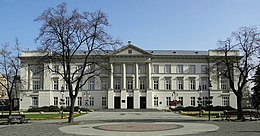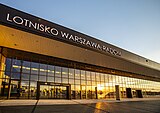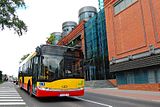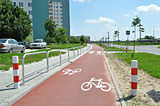Radom
Radom | |
|---|---|
| |
|
Radom Airport | |
| Website | http://www.radom.pl |
Radom
For centuries, Radom was part of the
The city is home to the biennial
The international Radom Jazz Festival and the International Gombrowicz Theater Festival are held in the city.
History

Radom's original settlement dates back to the 8th–9th century. It was an early medieval town in the valley of the Mleczna River (on the approximate site of present-day Old Town). In the second half of the 10th century, it became a
| Year | Pop. | ±% |
|---|---|---|
| 1950 | 80,298 | — |
| 1960 | 130,116 | +62.0% |
| 1970 | 159,480 | +22.6% |
| 1980 | 191,053 | +19.8% |
| 1990 | 228,487 | +19.6% |
| 2000 | 230,492 | +0.9% |
| 2010 | 222,496 | −3.5% |
| 2020 | 209,296 | −5.9% |
| source [5] | ||
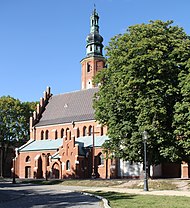
In the second half of the 13th century, Radom was granted a
In 1364, Radom's obsolete Środa Śląska rights were replaced with more modern Magdeburg rights, and residents gained several privileges as a result.[6] At that time, Radom was located along the so-called Oxen Trail, from Ruthenian lands to Silesia. In 1376, the city became the seat of a starosta, and entered the period of its greatest prosperity.[7]
Poland's Golden Age
King
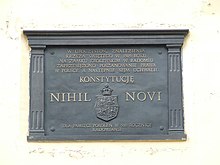
In 1481, Radom became the residence of Prince
The period of prosperity ended during the Swedish invasion of Poland. The Swedish army captured the city without a fight in November 1655. At first the invaders behaved correctly, as King Charles X Gustav still sought alliances within the Polish-Lithuanian nobility; the situation changed, however, in early 1656, when anti-Swedish uprisings broke out in southern Lesser Poland and quickly spread across the country. Radom was looted and almost completely destroyed in August 1656. Its population shrank from some 2,000 before the war, to 395 in 1660, with only 37 houses still standing. Swedish soldiers burned the royal castle and the monastery. With the Polish population in decline, the number of Jewish settlers grew by the early 18th century. In 1682 the first Piarists arrived, and in 1737–1756, opened a college.[11] The 3rd Infantry Regiment of the Polish Crown Army was stationed in Radom at various times.[12]
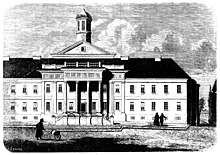
Late modern era
Radom remained within the Sandomierz Voivodeship of the
During World War I, the city was captured by the Austro-Hungarian Army in July 1915. An Austrian garrison remained until November 1918.

In the
World War II
On September 1, 1939, the first day of the German invasion of Poland and World War II, the Germans air raided the city.[17] On September 8, 1939, Radom was captured by the Wehrmacht, and was afterwards occupied by Germany. On September 21, 1939, the German Einsatzgruppe II entered the city to commit various crimes against the population, and afterwards its members co-formed the local German police and security forces.[18] The Germans immediately confiscated the food stored in warehouses in Radom and nearby settlements, and carried out requisitions in the city council.[19] The occupiers established a special court in Radom,[20] and two temporary prisoner-of-war camps for captured Polish soldiers, one in the pre-war military barracks and one in the Tadeusz Kościuszko Park.[21] There were poor conditions in the camp in the barracks, and hunger and diseases were common.[22] The local civilian population helped many POWs escape from the camp.[23]
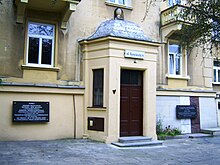
From October 1939 to January 1940, the Germans carried out several public executions of Polish civilians in various locations in Radom, killing 111 people.[24] The Germans also operated a heavy prison in the city,[25] and carried mass arrests of hundreds of Poles, who were then held in the prison.[26] Many Poles expelled from Gdynia in 1939 were placed in a temporary transit camp in a local church, before they were sent to nearby settlements.[27]
The occupiers liquidated local cultural and social life.[28] All sports clubs and high schools were closed, and teaching of literature, geography and history in the remaining schools was prohibited.[29]
In March and May 1940, the Germans carried out massacres of 210 Poles, including teenagers, from Radom and nearby settlements in the city's Firlej district.[30] Around 100 Poles from Radom were murdered by the Russians in the large Katyn massacre in April–May 1940.[31] In July, August and November 1940, the Germans carried out deportations of Poles from the local prison to the Auschwitz concentration camp.[32] Deportations to concentration camps continued throughout the war, and 18,000 people passed through the local prison, mostly Polish political activists, resistance members and innocent people, plus ordinary criminals.[33] At the large massacre sites in the present-day districts of Firlej and Kosów, the Germans murdered around 15,000 and 1,500 people, respectively.[34]
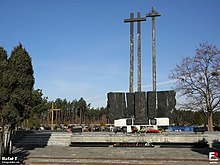
In October 1940, the German occupiers established a forced labour camp for Jews,[35] and in 1941, they formed the Radom Ghetto, with a population of 34,000 Jews, most of whom perished at the Treblinka extermination camp.[17] According to German regulations, sheltering Jews outside the ghetto was punishable by death.[36] The secret Polish Council to Aid Jews "Żegota", established by the Polish resistance movement operated in the city.[37]
Radom was a center of Polish resistance, with various organizations, such as
In 1944, following the Polish Warsaw Uprising, the Germans deported thousands of Varsovians from the Dulag 121 camp in Pruszków, where they were initially imprisoned, to Radom.[40] Those Poles were mainly old people, ill people and women with children.[40] 3,500 Poles expelled from Warsaw stayed in the city, as of November 1, 1944.[40]
In January 1945, the occupiers sent the last transport of prisoners from Radom to Auschwitz, but it only reached Częstochowa, while the remaining prisoners were massacred in Firlej.[33]
On January 16, 1945, the city was captured by the

Up to the
Current events
From 1975 to 1998, it was the seat of the Radom Voivodeship. In 1954 and 1984, city limits were greatly expanded by including several settlements as new districts,[43] including Długojów Górny, Huta Józefowska, Janiszpol, Józefów, Kierzków, Kończyce, Krychnowice, Krzewień, Malczew, Mleczna, Nowa Wola Gołębiowska, Nowiny Malczewskie, Stara Wola Gołębiowska, Wincentów, Wólka Klwatecka.[44]
In 2007, two pilots died in an accident at the air show, resulting in the cancellation of the rest of the event. On 30 August 2009, also during the air show, another two pilots who represented Belarus were killed when their plane crashed.
Radom was one of the main centres of the strike action taken by Polish health care workers in 2007.
Geography
Climate
Radom has a humid continental climate (Köppen: Dfb).
| Climate data for Radom | |||||||||||||
|---|---|---|---|---|---|---|---|---|---|---|---|---|---|
| Month | Jan | Feb | Mar | Apr | May | Jun | Jul | Aug | Sep | Oct | Nov | Dec | Year |
| Daily mean °C (°F) | −4.7 (23.5) |
−3.3 (26.1) |
2.1 (35.8) |
8.4 (47.1) |
13.2 (55.8) |
16.4 (61.5) |
18.0 (64.4) |
17.4 (63.3) |
13.7 (56.7) |
8.8 (47.8) |
3.2 (37.8) |
−1.9 (28.6) |
7.6 (45.7) |
| Average precipitation mm (inches) | 26 (1.0) |
25 (1.0) |
28 (1.1) |
37 (1.5) |
59 (2.3) |
76 (3.0) |
79 (3.1) |
66 (2.6) |
45 (1.8) |
36 (1.4) |
38 (1.5) |
34 (1.3) |
549 (21.6) |
| Source: Climate-Data.org[45] | |||||||||||||
Places of interest
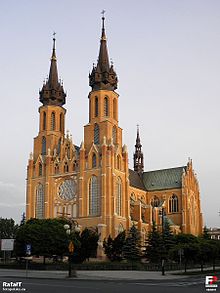
- Leszek I the White, built in the 13th century in Gothicstyle
- St John the Baptist Church: founded by Casimir III, built in the years 1360–1370 in gothic style, and re-constructed many times
- Bernardine Church and monastery: founded by Casimir IV of Poland, built in the years 1468–1507
- Holy Trinity Church: built in the years 1619–1627 in Baroque style, burned in a fire and was rebuilt in the years 1678–1691
- Gąska's and Esterka's Houses from the 16th–17th century
- Evangelical Church of the Augsburg Confession: built in 1785
- Sandomierz Palace: building of voivodeship council, built in the years 1825–1827, designed in classical style by Antonio Corazzi
- City hall: built in the years 1847–1848
- Cathedral of Virgin Mary: built in the years 1899–1908 in Gothic Revival style
- Resursa Citizen's Club building built in 1852
- Podworski House built in the Renaissance Revivalstyle in 1867
- Tool gates: built in the nineteenth century in classical style
- Tadeusz Kościuszko Park opened in 1867
- Radom Air Show: the most popular air show in Poland
Culture
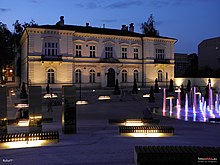
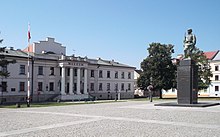
The arts
Philharmonic
- Radom Chamber Orchestra established in 2007[46]
Cinemas
Theatre
- Jan Kochanowski Theatre[48]
Museums and art galleries
- Jacek Malczewski Museum[49]
- Modern art museum[50]
- Scouting Museum
- "Elektrownia" - Power station built in 1903, renewed as a Modern art gallery
- Cultural Heritage Gallery of Radom
- Skansen in Radom[51]
Sports

- basketball team, founded in 2003, currently playing in the Polish Basketball League (country's top division) and the international Basketball Champions League.
- Czarni Radom - men's volleyball team, founded in 1921, currently playing in the PlusLiga (Poland's top division).
- Radomiak Radom - men's football team, founded in 1910, currently playing in the Ekstraklasa (top tier).
- Broń Radom - men's football team, founded in 1926, currently playing in the III liga (fourth tier).
- Jadar Radom - defunct men's volleyball team, which played in the PlusLiga in 2006–10.
Transport
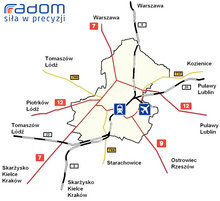
Radom is an important railroad junction, where two lines meet: east–west connection from Lublin to Łódź, and north–south from Warsaw to Kielce, and Kraków. The city is also located close to
- Transport in Radom - Gallery
-
Radom Airport
-
Bus Solaris Urbino 12
-
Main railway station
-
Biking in Radom
Education

Radom is home to about 20 schools of higher education:

- University of Radom (Uniwersytet Radomski)[52]
- Instytut Teologiczny Uniwersytetu Kardynała Stefana Wyszyńskiego w Radomiu - department of theology
- Kolegium Nauczycielskie[53]
- Nauczycielskie Kolegium Języków Obcych[54]
- Niepubliczne Nauczycielskie Kolegium Języków Obcych[55]
- Niepubliczne Nauczycielskie Kolegium Języków Obcych TWP[56]
- University College of Environmental Sciences (Wyższa Szkoła Ochrony Środowiska)[57]
- Radomska Szkoła Zarządzania
- Warsaw Agricultural University - department in Radom (Szkoła Główna Gospodarstwa Wiejskiego w Warszawie)
- College of the Maria Curie-Skłodowska University (Kolegium licencjackie Uniwersytetu Marii Curie-Skłodowskiej)[58]
- Maria Curie-Skłodowska University - department in Radom (Uniwersytet Marii Curie-Skłodowskiej)[61]
- Wyższa Inżynierska Szkoła Bezpieczeństwa i Organizacji Pracy[62]
- Higher Business College (Wyższa Szkoła Biznesu)[63]
- Higher Financial and Banking College (Wyższa Szkoła Finansów i Bankowości)[64]
- Higher Merchant College (Wyższa Szkoła Handlowa)[65]
- Higher Seminary (Wyższe Seminarium Duchowne)[66]
- Higher Journalis College (Wyższa Szkoła Dziennikarska)[67]
- Zespół Szkół Medycznych[68]
Other
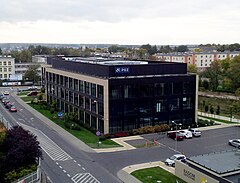
- At the Western part of Radom, there is a facility for commercial LF transmission (not broadcasting), the Radom longwave transmitter
- The Łucznik Arms Factory in Radom produces a range of military firearms such as assault rifles
- The book, Outcry - Holocaust Memoirs, by Manny Steinberg, chronicles a young Jewish man's life and trials during the Nazi occupation of Radom and beyond. Published by Amsterdam Publishers, The Netherlands in 2014.
- The Kurc family lives in Radom at the opening of the narrative non-fiction novel We Were the Lucky Ones by Georgia Hunter.
Politics
Members of Parliament (Sejm) elected from Radom constituency
- Ewa Kopacz (PO)
- Dariusz Bąk (PIS)
- Mirosław Maliszewski (PSL)
- Czesław Czechyra (PO)
- Marek Suski (PIS)
- Marek Wikiński (SLD),
- Radosław Witkowski (PO)
- Krzysztof Sońta (PIS)
- Sandra Pachocka (NIC)

International relations
Twin towns — sister cities
Radom is
|
Former twin towns:
- Homyel, Belarus
 Ozyory, Moscow Oblast, Russia
Ozyory, Moscow Oblast, Russia
On 28 February 2022, Radom ended its partnership with the Russian city of Ozyory and the Belarusian city of Homyel as a reaction to the
Notable people
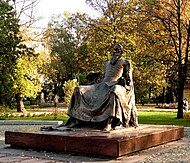

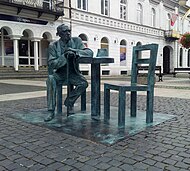
Notable people who have been born, have lived or have worked in Radom:
|
Notes
References
- ^ "GUS - Bank Danych Lokalnych". bdl.stat.gov.pl. Retrieved 2023-11-21.
- ^ "Radom". Lexico UK English Dictionary. Oxford University Press. Archived from the original on 2020-03-22.
- ^ "GUS - Bank Danych Lokalnych". bdl.stat.gov.pl. Retrieved 2023-11-21.
- ^ "Historia". Retrieved 6 April 2020.
- ^ "Radom (Mazowieckie) » mapy, nieruchomości, GUS, noclegi, szkoły, regon, atrakcje, kody pocztowe, wypadki drogowe, bezrobocie, wynagrodzenie, zarobki, tabele, edukacja, demografia".
- ^ a b "Historia miejscowości". Retrieved 6 April 2020.
- ^ "Grody mazowieckie". Retrieved 6 April 2020.
- ^ "RADOM – Kościół rektoralny pw. św. Katarzyny w Radomiu – OO. Bernardyni". Retrieved 6 April 2020.
- ^ "Historia Radomia". Retrieved 6 April 2020.
- ^ Województwo sandomierskie w drugiej połowie XVI wieku; Cz.1, Mapy, plany (in Polish). Warszawa: Wydawnictwo Naukowe PWN. 1993. p. 3.
- ^ "Kolegium Pijarów". Retrieved 6 April 2020.
- ^ Gembarzewski, Bronisław (1925). Rodowody pułków polskich i oddziałów równorzędnych od r. 1717 do r. 1831 (in Polish). Warszawa: Towarzystwo Wiedzy Wojskowej. pp. 26–27.
- ^ Gembarzewski, p. 69
- ISBN 978-83-8088-801-2.
- ^ Radomskie miejsca pamięci II wojny światowej (in Polish). Radom. 2010. pp. 12–13.
{{cite book}}: CS1 maint: location missing publisher (link) - ^ ISSN 1641-9561.
- ^ a b "Historia miejscowości". Retrieved 6 April 2020.
- ^ Wardzyńska, Maria (2009). Był rok 1939. Operacja niemieckiej policji bezpieczeństwa w Polsce. Intelligenzaktion (in Polish). Warszawa: IPN. p. 58.
- ^ Wardzyńska, p. 118
- ISSN 1641-9561.
- ^ Radomskie miejsca pamięci II wojny światowej, p. 14, 28
- ^ Radomskie miejsca pamięci II wojny światowej, p. 15
- ^ Radomskie miejsca pamięci II wojny światowej, p. 17
- ^ Wardzyńska, p. 250-251
- ^ "Schweres NS-Gefängnis Radom". Bundesarchiv.de (in German). Retrieved 8 May 2021.
- ^ Wardzyńska, p. 252
- ISSN 1641-9561.
- ^ a b c Radomskie miejsca pamięci II wojny światowej, p. 2
- ^ Radomskie miejsca pamięci II wojny światowej, p. 2, 9
- ^ Wardzyńska, p. 252-253
- ^ Weronika Chochoł. "Polegli na Golgocie Wschodu..." Radio Plus Radom (in Polish). Retrieved 8 May 2021.
- ^ Wardzyńska, p. 261
- ^ a b c d e f Radomskie miejsca pamięci II wojny światowej, p. 13
- ^ Radomskie miejsca pamięci II wojny światowej, p. 20
- ^ "Zwangsarbeitslager für Juden Radom". Bundesarchiv.de (in German). Retrieved 8 May 2021.
- ^ Datner, Szymon (1968). Las sprawiedliwych (in Polish). Warszawa: Książka i Wiedza. p. 23.
- ^ Datner, p. 69
- ^ Radomskie miejsca pamięci II wojny światowej, p. 6-7, 17
- ^ Radomskie miejsca pamięci II wojny światowej, p. 14
- ^ a b c "Transporty z obozu Dulag 121". Muzeum Dulag 121 (in Polish). Retrieved 8 May 2021.
- ^ See also: Alfred Lipson, ed. and comp., The Book of Radom: The Story of a Jewish Community in Poland Destroyed by the Nazis (New York, 1963), based on Sefer Radom, ed. Yitsḥak Perlov (Tel Aviv, 1961); Sebastian Piątkowski, Dni życia, dni śmierci: Ludność żydowska w Radomiu w latach 1918–1950 (Warsaw, 2006).
- ^ Rozporządzenie Rady Ministrów z dnia 22 sierpnia 1953 r. w sprawie zmiany granic miasta Radomia w województwie kieleckim., Dz. U. z 1953 r. Nr 41, poz. 190
- ^ Rozporządzenie Ministra Administracji i Gospodarki Przestrzennej z dnia 3 marca 1984 r. w sprawie zmiany granic niektórych miast w województwach: katowickim, kieleckim, legnickim, radomskim i wrocławskim., Dz. U. z 1984 r. Nr 14, poz. 64
- ^ "Climate: Radom". Climate-Data.org. Retrieved 18 April 2014.
- ^ Radom Chamber Orchestra
- ^ Helios cinemas Archived 2006-02-19 at the Wayback Machine
- ^ Jan Kochanowski Theatre
- ^ Jacek Malczewski Museum
- ^ Modern art museum
- ^ Skansen in Radom
- ^ Uniwersytet Radomski
- ^ Kolegium Nauczycielskie
- ^ Nauczycielskie Kolegium Języków
- ^ Nauczycielskie Kolegium Języków Archived 2006-02-16 at the Wayback Machine
- ^ Nauczycielskie Kolegium Języków TWP
- ^ Wyższa Szkoła Ochrony Środowiska
- ^ Kolegium licencjackie Archived 2005-12-28 at the Wayback Machine
- ^ Warsaw University department in Radom
- ^ Uniwersytet Warszawski
- ^ Uniwersytet Marii Curie-Skłodowskiej Archived 2003-09-26 at the Wayback Machine
- ^ Wyższa Inżynierska Szkoła Bezpieczeństwa
- ^ Wyższa Szkoła Biznesu
- ^ Wyższa Szkoła Finansów i Bankowości
- ^ Wyższa Szkoła Handlowa
- ^ Wyższe Seminarium Duchowne
- ^ Wyższa Szkoła Dziennikarska
- ^ www
- ^ a b c d e f g h i j k "Radom - Miasta partnerskie" [Radom - Partnership cities]. Miasto Radom [City of Radom] (in Polish). Archived from the original on 2013-04-03. Retrieved 2013-08-07.
- ^ a b c d e f g h "Radom - miasta partnerskie" (in Polish). radom.naszestrony.pl. Archived from the original on 2007-07-26. Retrieved 2013-08-07.
- ^ "Banská Bystrica Sister Cities". © 2001-2008. Archived from the original on 2009-03-02. Retrieved 2008-10-23.
- ^ Zachert, Uwe; Annica Kunz. "Twin cities". Landeshauptstadt Magdeburg [City of Magdeburg]. Archived from the original on 2012-09-01. Retrieved 2013-08-07.
- ^ "Radom zerwał współpracę z rosyjskim i białoruskim miastem. Obywatele Ukrainy autobusami będą jeździć za darmo" (in Polish). Retrieved 12 March 2022.
- ^ "Manny Steinberg".
External links
- . Encyclopædia Britannica. Vol. 22 (11th ed.). 1911. p. 810.
- Kropotkin, Peter Alexeivitch; Bealby, John Thomas (1911). . Encyclopædia Britannica. Vol. 22 (11th ed.). p. 810.
- Official web page of Radom in English
- Official web page of Radom in Polish
- Radom Culture (in Polish)
- (in Polish) http://www.nasz-radom.pl/
- Radom photo gallery (in Polish)
- Jewish Community in Radom on Virtual Shtetl
- Radom, Poland at JewishGen

